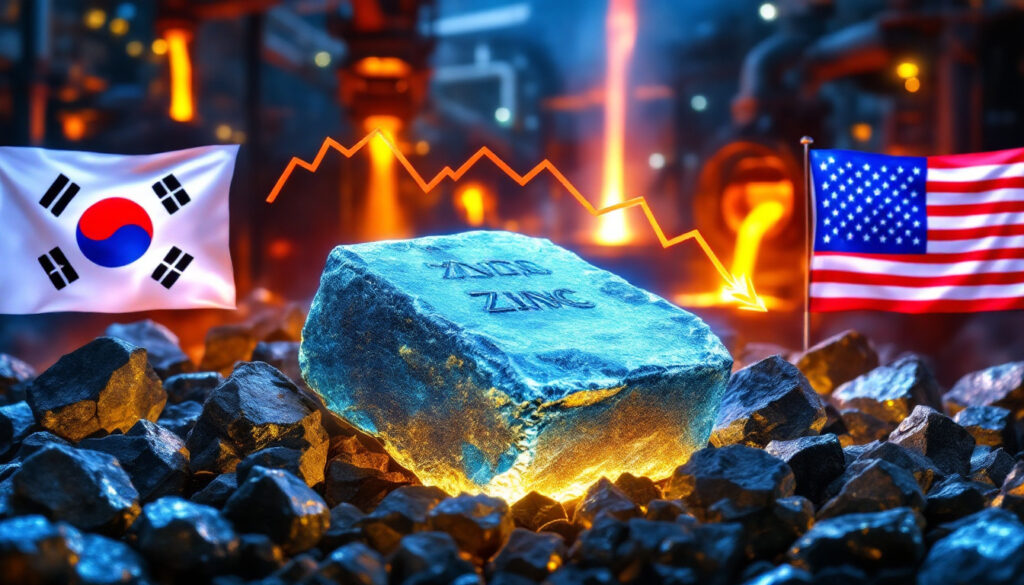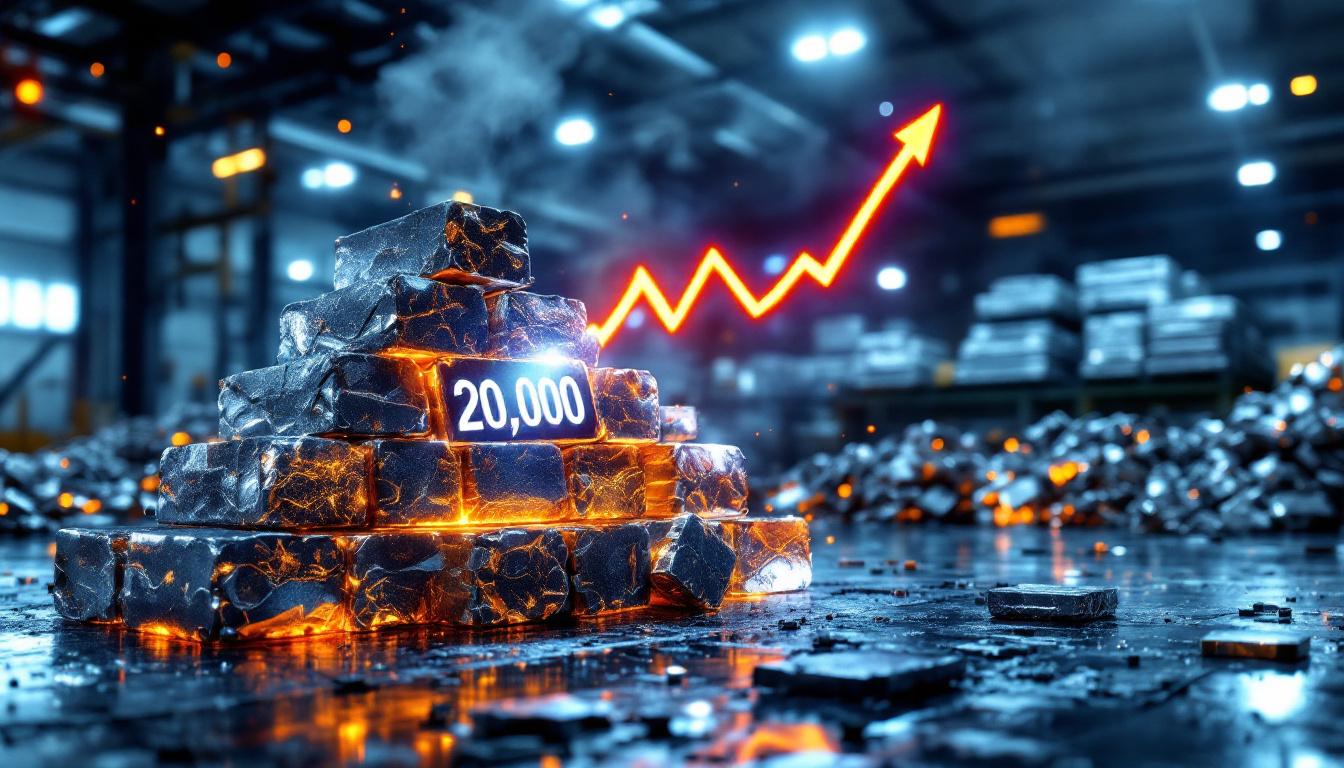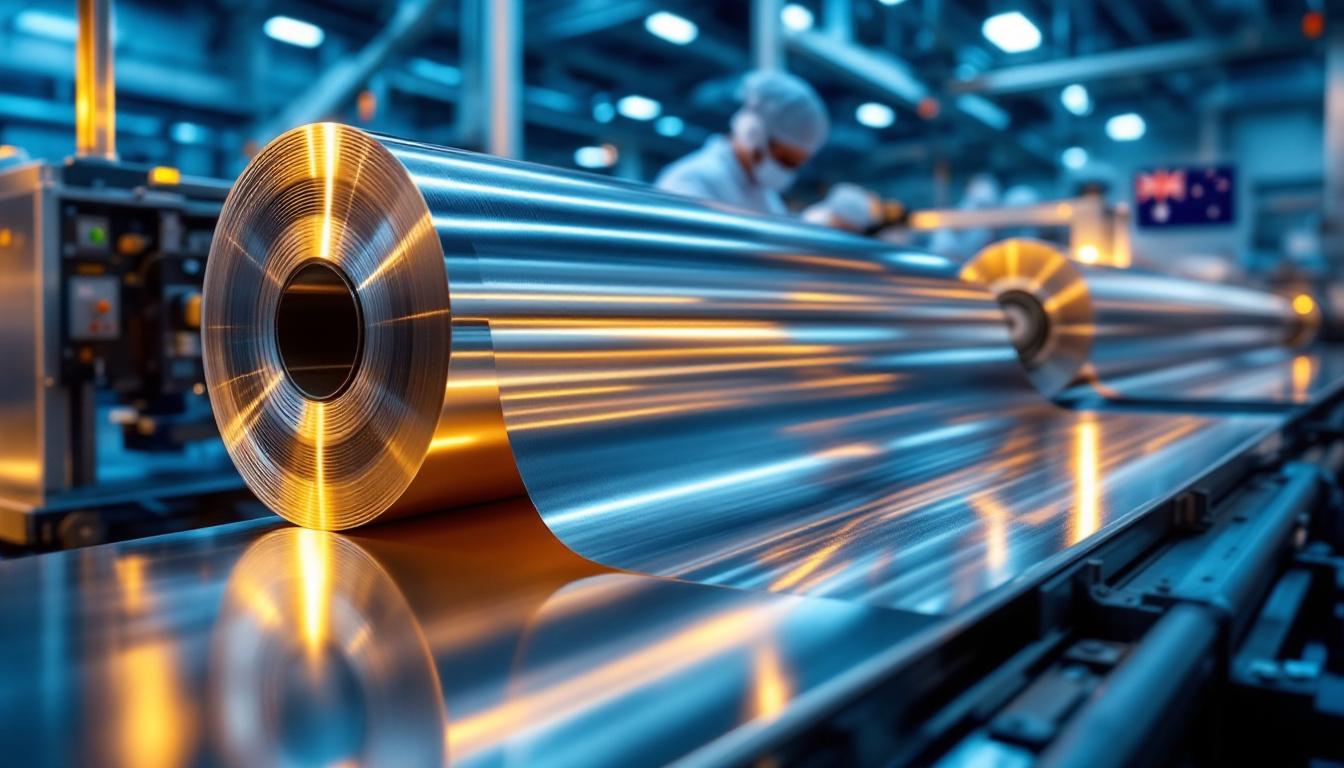Korea Zinc Agrees to 52% Cut in Fees to Turn Teck's Ores into Metal: Understanding the Impact
In a significant development for the global metal processing industry, Korea Zinc has agreed to slash its treatment charges for processing Teck Resources' zinc concentrates by a substantial 52%. This dramatic reduction reflects profound changes in market dynamics and signals potential disruptions across the zinc supply chain, impacting everything from mining operations to consumer products. Understanding these shifts is crucial for investors looking at mining and finance industry predictions for 2025 and their potential implications.
What is the Significance of Korea Zinc's Fee Reduction?
The agreement between Korea Zinc and Teck Resources represents one of the most substantial treatment charge reductions in recent memory, dropping from $165 per ton in the previous year to just $80 per ton for 2024. This dramatic 52% cut specifically covers zinc concentrates from Teck's Red Dog mine in Alaska, which produces approximately 550,000 metric tons of zinc annually, making it one of the world's largest zinc operations.
The 52% Treatment Charge Cut Explained
Treatment charges are fees paid to smelters for converting mineral concentrates into refined metal. These charges typically form the foundation of the smelting industry's revenue model. The annual negotiations between Teck Resources and Korea Zinc are particularly significant because they often establish the benchmark that influences pricing across the entire zinc industry.
The sharp decline from $165 to $80 per ton reflects an intensifying imbalance between mine output and smelting capacity. Notably, previous significant drops in treatment charges, such as the 45% reduction seen in 2009, led to approximately 12% of global smelting capacity shuttering operations – a concerning historical precedent for today's market participants.
Industry analysts note that Red Dog's high-grade concentrates and Teck's strategic position as a major supplier have strengthened the miner's negotiating leverage. This benchmark agreement could trigger a cascade of similar reductions across the industry, fundamentally altering the economics of zinc processing worldwide.
Impact on Global Zinc Smelting Industry
Treatment charges typically account for one-third of zinc smelters' revenue, making this reduction particularly devastating for processing companies. Korea Zinc, which generated approximately $2.1 billion in smelting revenue in 2023, faces a significant hit to its operating margin, which is projected to drop from 14% in 2023 to just 7% in 2024.
The sharp decline threatens profitability across the entire zinc smelting sector, with Wood Mackenzie analysis suggesting that approximately 50% of global smelters are now operating at a loss under current market conditions. This financial pressure is creating immediate challenges for global smelting market dynamics, particularly for operations with higher operating costs or less favorable energy arrangements.
Industry consolidation appears inevitable, with many smaller smelters facing existential decisions. As Nyrstar's CEO bluntly stated, "Smelters face existential risk below $100/ton thresholds," highlighting the severity of the current market conditions for processors.
Why Are Zinc Processing Fees Collapsing?
The dramatic reduction in treatment charges reflects fundamental supply-demand imbalances within the zinc processing ecosystem. Understanding these dynamics provides insight into both immediate market impacts and longer-term industry trends.
Growing Mismatch Between Smelting Capacity and Ore Availability
Spot market treatment charges have collapsed in recent months, falling from approximately $230 per ton in 2022 to around $60 per ton in 2024. This precipitous decline stems from a widening gap between global smelting capacity and available mined zinc concentrates. While global zinc mine output has grown at a modest 1.2% year-over-year rate, smelting capacity has expanded at a much more aggressive 3.8%, according to International Lead and Zinc Study Group (ILZSG) data.
This supply-demand imbalance has created significant leverage for mining companies like Teck Resources, which control access to increasingly scarce zinc concentrates. With smelters competing for limited ore supplies, miners have gained unprecedented negotiating power, allowing them to dictate more favorable terms.
The structural issues in the zinc market present long-term challenges for processors, particularly as concentrate quality issues compound the problem. Average zinc ore grades have declined approximately 30% since 2000, according to USGS data, meaning processors must handle more material to extract the same amount of zinc, further pressuring margins.
Economic Pressure on Smelting Operations
The plunging treatment charges are forcing smelters to consider dramatic measures, including production cuts or complete suspensions of operations. Most visibly, Trafigura Group has launched a strategic review of its struggling Nyrstar assets in Australia, even approaching the government for potential subsidies to maintain operations and preserve jobs. The company has explicitly stated that "current treatment charges are unsustainable for maintaining Australian operations without intervention."
Similarly, commodities giant Glencore has initiated a comprehensive review of its global smelting assets, including its zinc operations in Canada that are currently operating at approximately 78% capacity due to margin pressures. According to internal communications, the company faces "global smelting margins at decade lows, necessitating asset reviews" with targets to achieve $300 million in annual smelting cost reductions.
These developments indicate an industry-wide reassessment of zinc and copper smelting economics, with energy costs representing 20-30% of smelting expenses further complicating the financial picture for many operations, particularly in regions with high electricity prices.
How Will This Impact the Zinc Supply Chain?
The rapidly evolving situation in zinc smelting has significant implications for metal availability, pricing, and industries that rely on steady zinc supplies for their operations.
Potential Production Cutbacks and Market Disruption
Growing expectations suggest that smelters will need to reduce output in response to unsustainable treatment charges. Nyrstar's Port Pirie smelter in Australia has already reduced output by approximately 15% in early 2025, and industry analysts predict similar moves across multiple regions in the coming months.
Some facilities may face complete suspension of operations, particularly older plants with higher operating costs or those lacking vertical integration advantages. The resulting bottlenecks in the refined zinc supply chain could create significant market disruptions, similar to those seen in 2018 when smelter strikes resulted in approximately $1.2 billion in delayed construction projects.
Market analysts at CRU Group warn that "supply disruptions could spike prices to $3,500/ton by late 2025," representing a significant increase from current levels. This price volatility would be exacerbated by historically low inventory levels, with London Metal Exchange warehouses currently holding approximately 192,000 tons, 23% below the five-year average.
Implications for Zinc-Dependent Industries
As the world's fourth most-used refined metal after iron, aluminum, and copper, zinc plays a critical role in numerous industrial applications. Approximately 65% of global zinc production is used for galvanizing steel to prevent corrosion, with the construction sector alone consuming 42% of the total supply according to the International Zinc Association.
The automotive industry, another major zinc consumer, faces potential disruptions if refined metal supplies tighten. As one automotive industry representative noted, "Zinc shortages may delay EV chassis production timelines," highlighting the metal's importance even in emerging electric vehicle manufacturing.
Solar farm construction, which relies heavily on galvanized steel structures, represents another vulnerable sector. With approximately $15 billion annually invested in solar infrastructure globally, disruptions to zinc supply could impact renewable energy deployment timelines and costs. The lack of viable substitutes for many zinc applications compounds this challenge, as aluminum-coated steel alternatives have achieved less than 5% market penetration despite decades of development.
What Does This Mean for Major Industry Players?
The shifting dynamics in the zinc market create clear winners and losers, with miners and smelters experiencing dramatically different impacts from the current situation.
Teck Resources' Strategic Position
Teck Resources' Red Dog mine in Alaska represents a crown jewel asset in the global zinc industry, positioning the company advantageously amid the current market disruption. With zinc division revenue of approximately $4.3 billion in 2023, representing about 18% of the company's total income, Teck has significant exposure to zinc market dynamics.
The company has leveraged current market conditions to secure remarkably favorable terms in its processing agreements. Beyond the headline 52% reduction in treatment charges, Teck's 2024 contracts with five Asian smelters reportedly exclude price renegotiation clauses, locking in advantageous terms even if market conditions shift.
Teck has further strengthened its position through selective vertical integration strategies, with approximately 12% of its zinc concentrate output processed through tolling agreements that bypass traditional smelter relationships. As Teck's CFO has noted, "Red Dog's low-cost operations buffer against market downturns," highlighting the mine's strategic importance within the company's portfolio.
Challenges for Global Smelting Companies
Korea Zinc faces a significant revenue reduction from the treatment charge cut, reflected in its share price decline of approximately 22% year-to-date, substantially underperforming the broader metals and mining sector. The company's ability to adapt to this new pricing reality will be closely watched by industry observers.
Trafigura's struggles with its Nyrstar assets highlight the severity of the situation for smelters without captive ore supplies. The company's reported $500 million subsidy request to the Australian government represents a desperate attempt to maintain operations in the face of unsustainable economics, raising questions about the viability of independent smelting operations.
The zinc smelting landscape appears poised for significant restructuring, with mergers and acquisitions potentially accelerating. In 2023 alone, the sector saw approximately 15 deals valued at $1.8 billion, including China's Zijin Mining acquiring a Peruvian smelting operation – a trend likely to continue as stronger players absorb distressed assets at discounted valuations.
What's Driving the Zinc Concentrate Shortage?
Understanding the fundamental reasons behind the concentrate shortage provides insight into both current market dynamics and longer-term industry trends.
Supply-Side Constraints in Zinc Mining
The zinc mining sector has experienced a significant investment drought, with no new major zinc mines approved since 2019. This represents an investment gap exceeding $10 billion according to SNL Metals & Mining data, creating a structural shortage that cannot be quickly resolved even with higher metal prices.
The development timeline for new zinc projects has extended considerably due to regulatory and environmental challenges. As one Rio Tinto geologist observed, "Permitting delays add 3-5 years to mine development cycles," substantially lengthening the time between discovery and production. Peru's Antamina mine expansion, for example, has been stalled by an 18-month environmental review process despite strong economic fundamentals.
Declining ore grades represent another significant challenge, with average zinc content in mined ore falling approximately 30% since 2000. This quality deterioration increases mining costs and reduces concentrate availability, further tightening the market. Additionally, Doe Run's Missouri lead-zinc complex closure in 2022 removed approximately 150,000 tons of annual capacity from the North American market, highlighting the ongoing challenges in maintaining existing production.
Zinc's Critical Industrial Role
Zinc's essential role in steel galvanization and corrosion protection ensures steady demand despite price fluctuations. The metal's unique properties in preventing rust and extending the lifespan of steel make it irreplaceable in many applications, with no viable substitutes available at commercial scale for most uses.
Infrastructure development globally drives consistent zinc consumption, with each offshore wind turbine requiring approximately 2.4 kg of zinc per kilowatt of generating capacity for corrosion protection. This translates to substantial zinc requirements for renewable energy deployments, adding another growth vector to traditional construction demand.
The metal's strategic importance in manufacturing and construction provides support for long-term pricing, even as short-term volatility creates challenges for supply chain participants. With approximately 64% of global zinc reserves subject to increasingly stringent ESG reporting requirements according to the Initiative for Responsible Mining Assurance (IRMA), the regulatory landscape adds another layer of complexity to future supply growth.
FAQs About the Zinc Processing Market
How do treatment charges work in metal processing?
Treatment charges represent fees paid to smelters for converting mineral concentrates into refined metal. The specific formula typically includes a base treatment charge (TC) per ton of concentrate plus a refining charge (RC) per pound of contained metal. For example, the current benchmark of $80 TC plus $0.08/lb refining charge. These fees typically account for approximately one-third of a smelter's revenue and are negotiated annually between miners and processors, with spot market rates fluctuating throughout the year based on immediate supply-demand dynamics.
Why is the Red Dog mine agreement significant?
The annual deals for concentrates from Teck's Red Dog mine in Alaska often serve as the benchmark for other deals in the zinc industry, making this 52% reduction potentially influential across the entire zinc processing sector. Red Dog's size (approximately 550,000 tons of annual zinc production) and high-quality concentrates give it outsized importance in market negotiations. Historically, the terms agreed between Teck and major smelters establish reference points for subsequent negotiations between other miners and processors, amplifying the impact of this dramatic fee reduction.
What are the potential consequences for zinc prices?
If smelters reduce production due to unprofitable treatment charges, refined zinc supply could tighten, potentially leading to higher prices for finished zinc products despite lower processing fees. CRU Group analysts project that continuing supply disruptions could push prices toward $3,500 per ton by late 2025, representing a significant increase from current levels. This price volatility would be magnified by low inventory levels, with LME warehouses holding approximately 23% less zinc than the five-year average. Counterintuitively, miners might benefit from both lower treatment charges and higher metal prices, while smelters face a challenging profit squeeze.
How might governments respond to smelter financial challenges?
As evidenced by Trafigura seeking support for its Australian operations, governments may face pressure to provide subsidies or other assistance to maintain domestic refining capacity for strategic metals like zinc. The estimated $500 million subsidy request highlights the magnitude of financial support potentially required to maintain operations. National security considerations regarding critical mineral processing, employment concerns in regions dependent on smelting operations, and broader global commodities market insights could motivate government intervention through direct subsidies, preferential energy rates, or tax incentives for struggling facilities. Furthermore, these challenges highlight broader governance challenges and strategic insights in mining operations that are increasingly relevant in today's global markets.
As the zinc processing landscape continues to evolve, the implications of Korea Zinc's fee reduction will reverberate throughout the industry, creating both challenges and opportunities for different participants in the supply chain. The resulting market dynamics may also reveal how Trump's tariff policies and global commodity markets could further influence mineral processing economics in the coming years.
Want to Identify the Next Major Mineral Discovery?
Discovery Alert instantly notifies investors about significant ASX mineral discoveries using its proprietary Discovery IQ model, converting complex market data into actionable investment insights. Explore why historic discoveries can deliver extraordinary returns by visiting Discovery Alert's dedicated discoveries page and start your 30-day free trial today.




